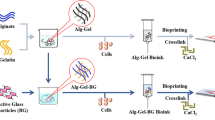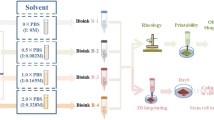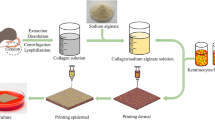Abstract
The polysaccharide alginate has received most extensive attention as bioink in bioprinting applications due to its ability to undergo gelation under cell-friendly conditions. However, absence of cell-binding motifs and the erratic degradation of alginate hydrogels have remained their persistent limitations. Honey is a conveniently available natural material, known for its role in wound healing and skin tissue regeneration. However, honey blending to improve biological response of alginate-based bioprinted scaffolds has not been yet reported. In the present work, honey-alginate bioinks were evaluated for their printability property (shape fidelity). It was found that honey blending reduced alginate viscosity, which gradually affected bioprinting fidelity. Therefore, the concentration that provides for acceptable bioprinting along with improvement in cell proliferations is determined. It is concluded that honey blending improves cell response of alginate bioinks and can be a facile approach to obtain bioinks especially for in situ skin tissue engineering applications.








Similar content being viewed by others
References
S. Bose, D. Ke, H. Sahasrabudhe, and A. Bandyopadhyay: Additive manufacturing of biomaterials. Prog. Mater. Sci. 93, 45 (2018).
I.T. Ozbolat, W. Pemg, and V. Ozbolat: Application areas of 3D bioprinting. Drug Discov. Today 21, 1257 (2017).
P.F. Egan, V.C. Gonella, M. Engensperger, S.J. Ferguson, and K. Shea: Computationally designed lattices with tuned properties for tissue engineering using 3D printing. PLoS One 12, e0182902 (2017).
W. Peng, P. Datta, B. Ayan, V. Ozbolat, D. Sosnoski, and I.T. Ozbolat: 3D bioprinting for drug discovery and development in pharmaceutics. Acta Biomater. 57, 26 (2017).
L. Ning and X. Chen: A brief review of extrusion-based tissue scaffold bio-printing. Biotechnol. J. 12, 1600671 (2017).
I.T. Ozbolat and M. Hospodiuk: Current advances and future perspectives in extrusion-based bioprinting. Biomaterials 76, 321 (2016).
N. Cubo, M. Garcia, J.F. Cañizo, D. Velasco, and J.L. Jorcano: 3D bioprinting of functional human skin: Production and in vivo analysis. Biofabrication 9 (2016).
S. Duchi, C. Onofrillo, C.D.O. Connell, R. Blanchard, A.F. Quigle, R.M.I. Kapsa, P. Peter, G. Wallace, C. Di Bella, and P.F.M. Choong: Handheld co-axial bioprinting: Application to in situ surgical cartilage repair. Sci. Rep. 7, 5837 (2017).
K.W. Binder, W. Zhao, T. Aboushwareb, D. Dice, A. Atala, and J.J. Yoo: In situ bioprinting of the skin for burns. J. Am. Coll. Surg. 211, S76 (2010).
M. Hospodiuk, M. Dey, D. Sosnoski, and I.T. Ozbolat: The bioink: A comprehensive review on bioprintable materials. Biotechnol. Adv. 35, 217 (2017).
S.K. Williams and J.B. Hoying: Bioinks for bioprinting. In Bioprinting in Regenerative Medicine, K. Turksen, ed. (Springer International Publishing, Cham, 2015); pp. 1–31.
K. Hölzl, S. Lin, L. Tytgat, S. Van Vlierberghe, L. Gu, and A. Ovsianikov: Bioink properties before, during and after 3D bioprinting. Biofabrication 8, 032002 (2016).
A. Abbadessa, M.M. Blokzijl, V.H.M. Mouser, P. Marica, J. Malda, W.E. Hennink, and T. Vermonden: A thermo-responsive and photo-polymerizable chondroitin sulfate-based hydrogel for 3D printing applications. Carbohydr. Polym. 149, 163 (2016).
T. Billiet, M. Vandenhaute, J. Schelfhout, S. Vlierberghe, and P. Dubruel: A review of trends and limitations in hydrogel-rapid prototyping for tissue engineering. Biomaterials 33, 6020–6041 (2012).
Z. Wu, X. Su, Y. Xu, B. Kong, W. Sun, and S. Mi: Bioprinting three-dimensional cell-laden tissue constructs with controllable degradation. Sci. Rep. 6, 24474 (2016).
J. Jia, D.J. Richards, S. Pollard, Y. Tan, J. Rodriguez, R.P. Visconti, T.C. Trusk, M.J. Yost, H. Yao, R.R. Markwald, and Y. Mei: Engineering alginate as bioink for bioprinting. Acta Biomater. 10, 4323 (2014).
Y. Luo, G. Luo, M. Gelinsky, P. Huang, and C. Ruan: 3D bioprinting scaffold using alginate/polyvinyl alcohol bioinks. Mater. Lett. 189, 295 (2017).
L.Q. Wan, J. Jiang, D.E. Arnold, X.E. Guo, H.H. Lu, and V.C. Mow: Calcium concentration effects on the mechanical and biochemical properties of chondrocyte-alginate constructs. Cell. Mol. Bioeng. 1, 93 (2008).
L. Vandamme, A. Heyneman, H. Hoeksema, J. Verbelen, and S. Monstrey: Honey in modern wound care: A systematic review. Burns 39, 1514 (2013).
S.K. Saikaly and A. Khachemoune: Honey and wound healing: An update. Am. J. Clin. Dermatol. 18, 237 (2017).
R.F. El-kased, R.I. Amer, D. Attia, and M.M. Elmazar: Honey-based hydrogel: In vitro and comparative in vivo evaluation for burn wound healing. Sci. Rep. 7, 9692 (2017).
D.S. Choi, S. Kim, Y. Lim, H. Gwon, J.S. Park, Y. Nho, J. Kwon, and C. Honey: Hydrogel incorporated with chestnut honey accelerates wound healing and promotes early HO-1 protein expression in diabetic (db/db) mice. Tissue Eng. Regener. Med. 9, 36 (2012).
J. Majtan: Honey: An immunomodulator in wound healing. Wound Repair Regen. 22, 187 (2014).
T. Wang, X.K. Zhu, X.T. Xue, and D.Y. Wu: Hydrogel sheets of chitosan, honey and gelatin as burn wound dressings. Carbohydr. Polym. 88, 75 (2012).
W.A. Sarhan and H.M.E. Azzazy: High concentration honey chitosan electrospun nanofibers: Biocompatibility and antibacterial effects. Carbohydr. Polym. 122, 135 (2015).
J. Tavakoli and Y. Tang: Honey/PVA hybrid wound dressings with controlled release of antibiotics: Structural, physico-mechanical and in-vitro biomedical studies. Mater. Sci. Eng., C 77, 318 (2017).
A. Chaudhury, S. Bag, A. Barui, P. Banerjee, and J. Chatterjee: Honey dilution impact on in vitro wound healing: Normoxic and hypoxic condition. Wound Repair Regen. 23, 412 (2015).
L. Wang, M. Xu, L. Luo, Y. Zhou, and P. Si: Iterative feedback bio-printing-derived cell-laden hydrogel scaffolds with optimal geometrical fidelity and cellular controllability. Sci. Rep. 8, 2802 (2018).
A. Ribeiro, M.M. Blokzijl, R. Levato, C.W. Visser, M. Castilho, W.E. Hennink, T. Vermonden, and J. Malda: Assessing bioink shape fidelity to aid material development in 3D bioprinting. Biofabrication 10, 014102 (2017).
L. Ouyang, C.B. Highley, C.B. Rodell, W. Sun, and J.A. Burdick: 3D printing of shear-thinning hyaluronic acid hydrogels with secondary cross-linking. ACS Biomater. Sci. Eng. 2, 1743 (2016).
L. Ouyang, R. Yao, Y. Zhao, and W. Sun: Effect of bioink properties on printability and cell viability for 3D bioplotting of embryonic stem cells. Biofabrication 8, 035020 (2016).
S. Kyle, Z.M. Jessop, A. Al-sabah, and I.S. Whitaker: “Printability” of candidate biomaterials for extrusion based 3D printing: State-of-the-art. Adv. Healthcare Mater. 6, 1700264 (2017).
M. Di Giuseppe, N. Law, B. Webb, R.A. Macrae, L.J. Liew, T.B. Sercombe, R.J. Dilley, and B.J. Doyle: Mechanical behaviour of alginate-gelatin hydrogels for 3D bioprinting. J. Mech. Behav. Biomed. Mater. 79, 150 (2018).
K.R. Hixon, T. Lu, M.N. Carletta, S.H. McBride-Gagyi, B.E. Janowiak, and S.A. Sell: A preliminary in vitro evaluation of the bioactive potential of cryogel scaffolds incorporated with Manuka honey for the treatment of chronic bone infections. J. Biomed. Mater. Res., Part B 106, 1918–1933 (2017).
R. Sarkar, A. Ghosh, A. Barui, and P. Datta: Repositing honey incorporated electrospun nanofiber membranes to provide anti-oxidant, anti-bacterial and anti-inflammatory microenvironment for wound regeneration. J. Mater. Sci.: Mater. Med. 29, 31 (2018).
Y. He, F. Yang, H. Zhao, Q. Gao, B. Xia, and J. Fu: Research on the printability of hydrogels in 3D bioprinting. Sci. Rep. 6, 1 (2016).
A. Schmitt, P. Rödel, C. Anamur, C. Seeliger, A.B. Imhoff, E. Herbst, S. Vogt, M. Van Griensven, G. Winter, and J. Engert: Calcium alginate gels as stem cell matrix-making paracrine stem cell activity available for enhanced healing after surgery. PLoS One 10, 1 (2015).
B.E. Larsen, J. Bjørnstad, E.O. Pettersen, H.H. Tønnesen, and J.E. Melvik: Rheological characterization of an injectable alginate gel system. BMC Biotechnol. 15, 1 (2015).
J.H.Y. Chung, S. Naficy, Z. Yue, R. Kapsa, A. Quigley, S.E. Moulton, and G.G. Wallace: Bio-ink properties and printability for extrusion printing living cells. Biomater. Sci. 1, 763 (2013).
J. Park, S.J. Lee, S. Chung, J.H. Lee, W.D. Kim, J.Y. Lee, and S.A. Park: Cell-laden 3D bioprinting hydrogel matrix depending on different compositions for soft tissue engineering: Characterization and evaluation. Mater. Sci. Eng., C 71, 678 (2017).
M. Di Giuseppe, N. Law, B. Webb, R.A. Macrae, T.B. Sercombe, R.J. Dilley, B.J. Doyle, and L.J. Liew: Journal of the mechanical behavior of biomedical materials mechanical behaviour of alginate-gelatin hydrogels for 3D bioprinting. J. Mech. Behav. Biomed. Mater. 79, 150 (2018).
G. Kaklamani, D. Cheneler, L.M. Grover, M.J. Adams, and J. Bowen: Mechanical properties of alginate hydrogels manufactured using external gelation. J. Mech. Behav. Biomed. Mater. 36, 135 (2014).
M. Ahearne, Y. Yang, and K. Liu: Mechanical characterisation of hydrogels for tissue engineering applications. Tissue Eng. 4, 1 (2008).
K.R. Hixon, T. Lu, S.H. McBride-Gagyi, B.E. Janowiak, and S.A. Sell: A comparison of tissue engineering scaffolds incorporated with manuka honey of varying UMF. BioMed Res. Int. 2017, 4843065 (2017).
B.A. Minden-Birkenmaier, R.M. Neuhalfen, B.E. Janowiak, and S. Sell: Preliminary investigation and characterization of electrospun polycaprolactone and manuka honey scaffolds for dermal repair. J. Eng. Fibers Fabr. 10, 126 (2015).
M. Rajput, N. Bhandaru, A. Barui, A. Chaudhary, R.R. Paul, R. Mukherjee, and J. Chatterjee: Nano-patterned honey incorporated silk fibroin membranes for improving cellular compatibility. RSC Adv. 4, 44674 (2014).
M. Funada, H. Hara, H. Sasagawa, Y. Kitagawa, and T. Kadowaki: A honey bee Dscam family member, AbsCAM, is a brain-specific cell adhesion molecule with the neurite outgrowth activity which influences neuronal wiring during development. Eur. J. Neurosci. 25, 168 (2007).
A. Nordin, N.Q.A.V. Sainik, M.S. Zulfarina, I. Naina-Mohamed, A. Saim, and R. Bt Hj Idrus: Honey and epithelial to mesenchymal transition in wound healing: An evidence-based review. Wound Med. 18, 8 (2017).
A. Oryan, E. Alemzadeh, and A. Moshiri: Biological properties and therapeutic activities of honey in wound healing: A narrative review and meta-analysis. J. Tissue Viability 25, 98 (2016).
A.C. Daly, F.E. Freeman, T. Gonzalez-Fernandez, S.E. Critchley, J. Nulty, and D.J. Kelly: 3D bioprinting for cartilage and osteochondral tissue engineering. Adv. Healthcare Mater. 6, 1700298 (2017).
K. Nair, M. Gandhi, S. Khalil, K.C. Yan, M. Marcolongo, K. Barbee, and W. Sun: Characterization of cell viability during bioprinting processes. Biotechnol. J. 4, 1168 (2009).
P. He, J. Zhao, J. Zhang, B. Li, Z. Gou, M. Gou, and X. Li: Bioprinting of skin constructs for wound healing. Burn. Trauma 6, 5 (2018).
A. Barui, P. Banerjee, A. Chaudhary, S. Conjeti, B. Mondal, S. Dey, and J. Chatterjee: Evaluation of angiogenesis in diabetic lower limb wound healing using a natural medicine: A quantitative approach. Wound Med. 6, 26 (2014).
ACKNOWLEDGMENTS
The authors acknowledge financial support from Department of Science and Technology, Govt. of India vide DST/IFA/12/LSBM/48 to PD and IIEST institute fellowship support to SD.
Author information
Authors and Affiliations
Corresponding author
Rights and permissions
About this article
Cite this article
Datta, S., Sarkar, R., Vyas, V. et al. Alginate-honey bioinks with improved cell responses for applications as bioprinted tissue engineered constructs. Journal of Materials Research 33, 2029–2039 (2018). https://doi.org/10.1557/jmr.2018.202
Received:
Accepted:
Published:
Issue Date:
DOI: https://doi.org/10.1557/jmr.2018.202




